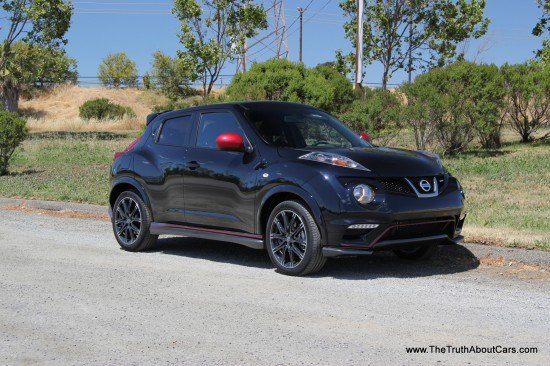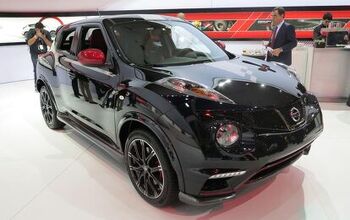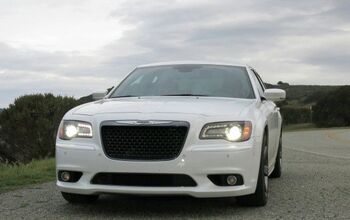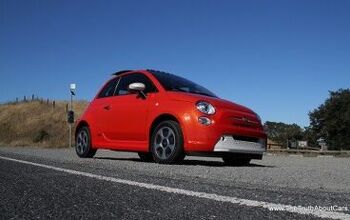Review: 2013 Juke Nismo (Video)

Let’s get one thing sorted. The picture above is not, I repeat not, the wasabi-snorting-485-horsepower-3.7-second-to-60 Juke that Nissan has been teasing. Instead, this is the Nismo treated Juke we saw at the Chicago Auto Show in February. If you’re disappointed, or if the unusual confluence of shapes that is the Juke has made you throw up a little in your mouth, don’t click past the jump. We warned you.
Exterior
Calling the Juke’s styling “not everyone’s cup of tea” (as one person I met put it) or even “polarizing” hardly begins to describe what’s going on here. My week with Nissan’s smallest crossover in America was filled with awkward stares, gaping mouths and looks of revulsion. But that’s not the whole story. For every 10 people that wanted to run the Juke out-of-town like villagers wielding pitchforks, there were two or three that thought it was fantastic looking. No, cross that, they wanted to bear the Juke’s children. That’s how far they went. This makes the Juke the most polarizing car design I have seen. Yes, I’m including the unholy Aztec and Rendezvous. However you feel about the Juke’s design, you have to admit it took some brass balls to design it, produce it, and then keep selling it.
Let’s toss in another photo:
Our own Sajeev Mehta performed one of his excellent “Vellum Venom” critiques of the Juke in March, so be sure you check that out. My personal reaction is mixed. I appreciate the overall dimensions of the Juke as most crossovers on the road are ridiculously over-sized, but I think that the design team got just a bit carried away. Especially with the front end. I don’t mind the round headlamps, the round proboscis doesn’t bother me at all, but those turn signal pods that rise from the hood reminded me of a frog. Frogs are tasty, but I don’t find them cute. Making them stand out even more is the fact that they can be seen inside by the driver and front passenger. That said, I appreciate polarizing designs because of the passion they inspire. If you’re one of those people who want to interbreed with a Juke, more power to you. One thing is for sure, you get an enormous heaping of style for Nismo’s $22,990 starting price.
Interior
Because the base Juke wears a starting MSRP of $18,990, my expectations were low. If you keep your expectations at a similarly realistic level, you’ll be pleasantly surprised. For $22,990 the Nismo version adds heavily bolstered Alcantara sport seats, a leather and Alcantara wrapped steering wheel, center arm rest, red tachometer, plenty of Nismo badges and red-stitching galore. Unfortunately, the standard hard plastic dashboard and the world’s least attractive headliner remain. Seriously, this has to be the same material the trunk liner in a Versa is crafted from, how much would it have cost for something out of the Altima? On the flip side, you have to keep reminding yourself that 27-large is as expensive as any Juke gets and the Nismo tops out at $26,460 with navigation, the CVT and AWD. That’s well below the average new car transaction price in America.
The Alcantara thrones are some of the most attractive (and best bolstered) seats you can find for under $30,000, but they still ride on the same 6-way manual driver’s and 4-way passenger’s seat frames as the regular Juke. This means the range of motion is limited and lumbar support is non-existent. Still, one must have perspective and you’ll find the same situation in most cars this price. I was disappointed to find that the Juke’s steering wheel doesn’t telescope making it hard for me to find an idea driving position.
Thanks to the hatchback-like profile, the rear seats offer more room than you’d think by looking at the outside with enough head and legroom for a quartet of adult men. More surprising, those four guy’s bags will fit in the Juke’s surprisingly large and deep trunk. The reason for that large cargo area (with more under the load floor) is the Juke’s fairly tall profile and low ride height which allows for a deep (if strangely shaped) cargo hold. (Check out the video to see under the load floor.)
Infotainment
Nismoing your Juke doesn’t improve the way your tunes sound, you get the same base AM/FM/XM/CD/iPod/USB head unit as the base Juke, with the same six unbranded speakers. For $1,150 you can add what Nissan used to call their “low-cost navigation unit” bundled with a Rockford Fosgate speaker system and 8-inch subwoofer. I was a bit skeptical about this combination, but the tuning of the RF system was surprisingly well-balanced for a factory up-sell. The big draw for me is the nav unit.
The nav system by itself seems to go for about $750 in other Nissan models and is one of the best navs on the market in my opinion. It’s not that it offers a huge feature set or slick graphics, what appeals to me is the low-cost and simple, straight-forward interface. The system has the basics covered from XM traffic and fuel prices to on-screen USB/iDevice integration and Bluetooth speakerphone integration. The one strange omission from the system is Bluetooth audio streaming which isn’t supported.
Drivetrain & Drive
Despite being the antithesis of square, the Cube and the Juke ride on the same Nissan Versa underpinnings. Thankfully the underpinnings are all they share. Instead of the wheezy 1.8L mill, Nissan cooked up an all-new 1.6L direct-injection four-cylinder for the Juke (they have since jammed it in foreign market Versas as well). The small engine is good for a [comparatively] large 197 horsepower (9 more than the regular Juke) and 184 lb-ft from 2,000 to 5,200 rpm (7 more). That’s a reasonable amount of power for something that could be seen as an upgrade from a loaded Sentra SR.
The Juke may be a funny looking creature with some cheap plastics inside, but even in base form it has road manners that impress. To create the Nismo, Nissan bumped up the tires to 224/45R18, stiffened the springs by 10%, tweaked the dampers, fiddled with the steering and bumped the final drive ratio. They then made the 6-speed manual transmission the standard cog-swapper rather than the CVT (standard in the regular Juke), added red mirror caps and called it a day.
A trick that is sometimes used to make the sporty version of a car more dynamic on the road is to swap out the electric power steering for a traditional hydraulic unit. When I first hit the curves in the Juke I assumed Nissan had employed this trick. Much to my surprise, Nissan didn’t do that. Instead they tweaked the EPAS (Electric Power Assist Steering) system for improved feedback and a different level of assist. The result is impressive but made me ask: why don’t all EPAS equipped Nissans feel like this? In truth, the feel is still lacking compared to the “good old days,” but the steering is notably more direct and linear with just a hint of feedback from the wide front rubber. This is as good as it gets with EPAS.
Before the Juke arrived I had spent a week in the 2013 BMW X6M (our reviews are obviously out of order). Having the Nismo and an X6M back to back may sound like a real let down, but there’s another side. Obviously the Juke doesn’t handle or accelerate like an M, but there is something of the personality that struck me. No, I’m not just talking about the X6 being similarly polarizing in the style department, I’m talking on the road personality. They are similarly “eager.” In this way, the Juke reminded me of a small dog that thinks it’s a big dog. It even has a chihuahua’s eyes. Is that good or bad? Good seeing as the Juke costs about 1/4th the price. I managed a 7.45 second 0-60 dash in the 6-speed manual model, let’s just say the X6M didn’t get there in 1/4th the time.
It gets a bit more complicated. You see, the Juke is two kinds of animal. If you get the 6-speed manual transmission you get plenty of torque steer, slick shifts and a more engaging ride. (And for some reason torque steer makes me smile when it’s on a small-scale like this.) If you get the AWD Nismo, you’re stuck with Nissan’s CVT. I’m no CVT hater but even I have to admit the CVT dulls the Juke’s personality. On the flip side, the torque vectoring AWD system makes the CVT/AWD Nismo the faster car on the track by a reasonable margin. If you have an oddly shaped place in your heart for Nissan’s over-styled crossover, you have a difficult decision on your hands. Either way the Juke is destined to be one of the rarer vehicles on American roads and I get the impression that’s just how lovers and haters of the Juke like it.
Hit it
- The best handling chihuahua on the road.
- Nissan’s torque vectoring AWD system is a hoot and a half.
Quit it
- Saying the Juke’s looks aren’t for everyone is being polite.
- What’s up with that headliner anyway?
Nissan provided the vehicle, insurance and one tank of gas for this review
Specifications as tested
0-30: 2.8 Seconds
0-60: 7.45 Seconds
1/4 Mile: 15.8 Seconds @ 90.5 MPH
Average Observed Fuel Economy: 27.8 MPG over 589 miles

More by Alex L. Dykes
Latest Car Reviews
Read moreLatest Product Reviews
Read moreRecent Comments
- El scotto No rag-top, no rag-top(s) = not a prestigious car brand. Think it through. All of the high-end Germans and Lexus have rag-tops. Corvette is really its own brand.World-leading engines. AMG, M, S and well Lexus is third-world tough. GM makes one of the best V-8s in the world in Bowling Green. But nooooo, noooo, we're GM only Corvettes get Corvette engines. Balderdash! I say. Put Corvette engines in the top-tier Cadillacs. I know GM could make a world-class 3.5 liter V-6 but they don't or won't. In the interior everything that gets touched, including your butt, has to feel good. No exceptions.Some think that those who pay above MSRP and brag about it are idiots. Go the opposite direction, and offer an extended 10-year 100,000-mile factory warranty. At a reasonable price. That's Acura's current business model.
- Carrera 2014 Toyota Corolla with 192,000 miles bought new. Oil changes every 5,000 miles, 1 coolant flush, and a bunch of air filters and in cabin air filters, and wipers. On my 4th set of tires.Original brake pads ( manual transmission), original spark plugs. Nothing else...it's a Toyota. Did most of oil changes either free at Toyota or myself. Also 3 batteries.2022 Acura TLX A-Spec AWD 13,000 miles now but bought new.Two oil changes...2006 Hyundai Elantra gifted from a colleague with 318,000 when I got it, and 335,000 now. It needed some TLC. A set of cheap Chinese tires ($275), AC compressor, evaporator, expansion valve package ( $290) , two TYC headlights $120, one battery ( $95), two oil changes, air filters, Denso alternator ( $185), coolant, and labor for AC job ( $200).
- Mike-NB2 This is a mostly uninformed vote, but I'll go with the Mazda 3 too.I haven't driven a new Civic, so I can't say anything about it, but two weeks ago I had a 2023 Corolla as a rental. While I can understand why so many people buy these, I was surprised at how bad the CVT is. Many rentals I've driven have a CVT and while I know it has one and can tell, they aren't usually too bad. I'd never own a car with a CVT, but I can live with one as a rental. But the Corolla's CVT was terrible. It was like it screamed "CVT!" the whole time. On the highway with cruise control on, I could feel it adjusting to track the set speed. Passing on the highway (two-lane) was risky. The engine isn't under-powered, but the CVT makes it seem that way.A minor complaint is about the steering. It's waaaay over-assisted. At low speeds, it's like a 70s LTD with one-finger effort. Maybe that's deliberate though, given the Corolla's demographic.
- Mike-NB2 2019 Ranger - 30,000 miles / 50,000 km. Nothing but oil changes. Original tires are being replaced a week from Wednesday. (Not all that mileage is on the original A/S tires. I put dedicated winter rims/tires on it every winter.)2024 - Golf R - 1700 miles / 2800 km. Not really broken in yet. Nothing but gas in the tank.
- SaulTigh I've got a 2014 F150 with 87K on the clock and have spent exactly $4,180.77 in maintenance and repairs in that time. That's pretty hard to beat.Hard to say on my 2019 Mercedes, because I prepaid for three years of service (B,A,B) and am getting the last of those at the end of the month. Did just drop $1,700 on new Michelins for it at Tire Rack. Tires for the F150 late last year were under $700, so I'd say the Benz is roughly 2 to 3 times as pricy for anything over the Ford.I have the F150 serviced at a large independent shop, the Benz at the dealership.














































































Comments
Join the conversation
I test drove the first Juke Nismo that arrived at my local dealer. Unfortunately it was a CVT model, but it was still quite fun to drive. The manual mode of the CVT didn't suck. I'd still like to drive the 6 speed version, though. I like the funky look of it. The only part of this review I take issue with is you stating that you can fit a quartet of adult men in the car. I'm just about 6'0" and if I drive with the seat all the way back it doesn't look like I could fit my children in the seat behind me, and they're 9 and 12. Honestly, it doesn't look like their legs would fit in the space between the front seat back and where their legs would go. Was I just imagining this?
This is a serious question. I know this car doesn't photo very well, but for all the haters, have you really looked at one in the flesh? To me, it looks quite "dynamic" in person, especially the rear hatch area. Considering the generally conservative nature of Japanese carmakers, I applaud the fact that somebody in Nissan even green-lit this project.